by Heather Plett | Jan 23, 2013 | circle
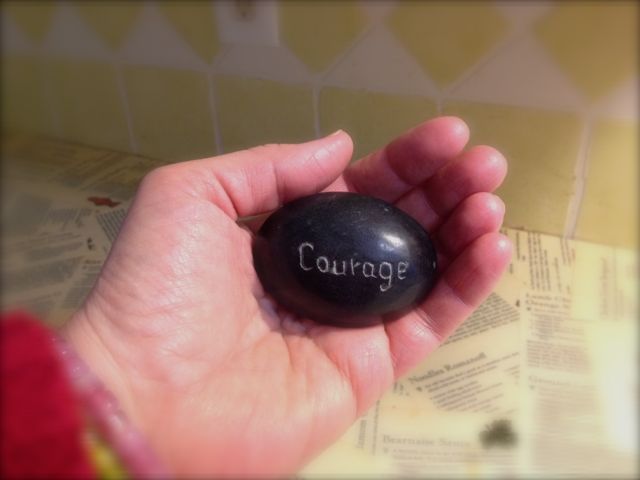
I’ve taken on the delightful task of co-hosting a women’s leadership learning circle that meets every second Tuesday in a rural community in our province. Yesterday’s circle focused on conflict resolution and difficult conversations.
We started the evening making collages that represented the things that we want to breathe out (release/stop doing) and breathe in (receive/embrace/learn) in relation to conflict in our lives. From there we moved into personal assessments of how we each respond to conflict. We talked about how each conflict is shaped by our level of commitment to the relationship and to the agenda at stake, and how we choose our conflict styles accordingly. The sharing in the circle was, as always, personal and intimate. There were stories of conflict in our workplaces, conflict in our marriages and family relationships, and conflict within ourselves.
At the end of the workshop, we asked the women to share what they had breathed in (received) and what they had been able to breathe out (release) throughout the course of the workshop. As they shared, we passed around a talking piece – the courage stone that was a gift from my friend Jo-Anne.
When the stone had completed the circle and returned to me, I said “it is always a pleasure to hold this stone after it has been in the hands of each of you in the circle. As it passes around the circle, it picks up energy from each of you, and that energy changes the rock. The colour becomes richer, and by the time it gets back to me, it is much warmer than it was when I first pulled it out of my bag. You have each given a piece of your energy to this circle and to this stone.”
Women’s circles are always the same. We bring little bits of courage, little bits of fear, little pieces of our stories, and little bits of our love. We pour it all into the container of the circle, we hold the edge for each other, and our offerings lend each of us a little bit more energy and courage than we put in.
It’s like a soup for which we each brought an ingredient. You may have only brought the carrots, but once the soup is done, once we’ve each had a chance to add our ingredients, we each have enough for a nourishing meal.
As we pass our stories around the circle, our courage grows and we all leave changed by the time we spent together.
by Heather Plett | Oct 26, 2012 | circle, Community, Compassion, Creativity, growth, journey, Leadership, Passion, Sophia
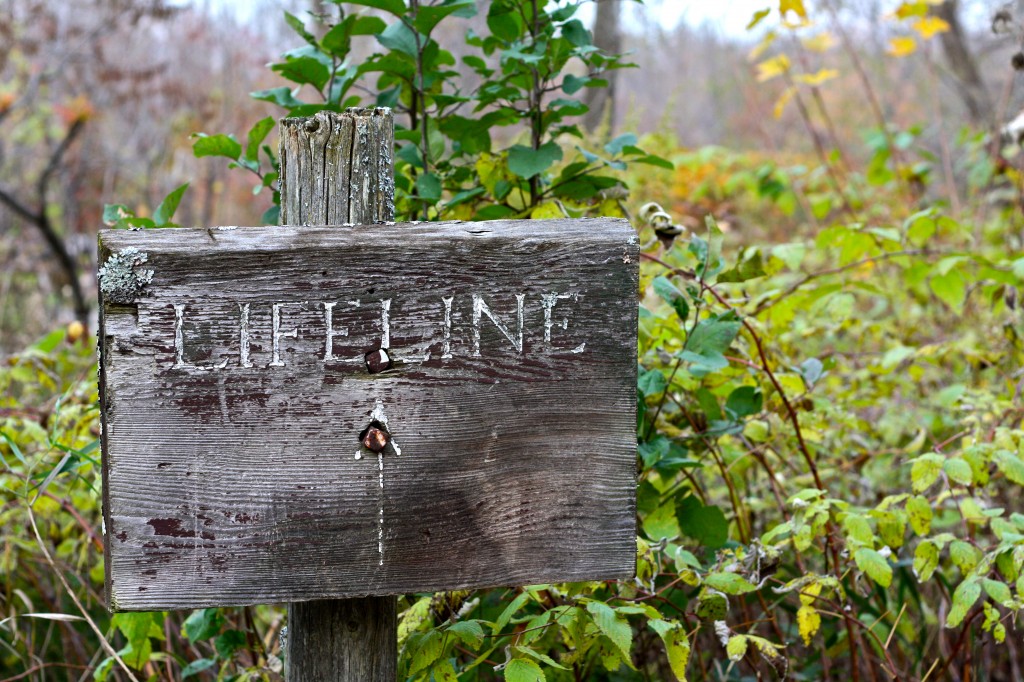 Ten years ago I was lost. I had just returned to work after my fourth and final maternity leave, and I was completely miserable. Not only was it hard to leave my baby every day, but I was in a job that didn’t sustain or inspire me. All it did was drain my energy every single day. In those days, it wasn’t unusual for tears to flow on the way home from work.
Ten years ago I was lost. I had just returned to work after my fourth and final maternity leave, and I was completely miserable. Not only was it hard to leave my baby every day, but I was in a job that didn’t sustain or inspire me. All it did was drain my energy every single day. In those days, it wasn’t unusual for tears to flow on the way home from work.
Five years earlier, I’d taken my first leadership job in the government and I took to it like a duck to water. I loved the challenge and I loved my team. I was inspired and energized by the opportunity to provide them guidance and unleash their creative potential. I had an eager and talented young staff and we worked together beautifully, finding creative ways to communicate and commemorate the sacrifices our veterans had made.
At the start, it was good, but then things started to go wrong. For one thing, I started to internalize some of the messaging I was hearing at leadership workshops and from leadership mentors. “Keep your feelings out of leadership.” “It’s about control and moderation, not about passion.” “Don’t let them see you vulnerable.” “Use your head and ignore your heart.”
For another thing, I stepped away from that first job to take one that offered higher pay and more security. Unfortunately, it was all wrong for me and the environment was toxic. It was a science environment where most of the leaders were in their roles because of their knowledge of science rather than their leadership abilities or their understanding of people. As a professional communicator, I was usually the only one at the management team table who didn’t have an advanced science degree. In an environment that valued left-brain logical thinking, there was little space for my right-brain, intuitive, heart-based approach to leadership.
I felt lost – like a foreigner in a foreign land. If this was what leadership entailed, I wasn’t sure I wanted to be a leader anymore.
And then one day, I started to explore a new way of looking at leadership (that was much closer to the way I’d intuitively lead when I’d first started) and it felt like someone had offered me a lifeline. I can’t remember whose work I discovered first, but three writers started to show up on my radar screen – Christina Baldwin, David Irvine, and Margaret Wheatley. All three wrote about authentic, community-based, vulnerable leadership. They inspired me to lead from a place in the circle, live simply in a complex world, and turn to one another. (I am deeply grateful that in the years since then, I’ve had the opportunity to attend workshops with all three of these incredible teachers.)
Not long after that, I left the government for non-profit. It was a job I loved, but it was also one that challenged me in more ways than I’d ever been challenged before. Every leadership ability that I thought I’d gained and every principle I thought I valued was put to the test. I led a national team that was mostly full of fiercely independent people who didn’t really want to be lead. I was emotionally abused, I had a lawsuit filed against me by someone who felt she was wrongfully dismissed, I witnessed more than one emotional breakdown among my staff, and I had to deal with multiple conflicts and miscommunications between staff. It was a good place to work, but it was hard and I often felt very much alone. I was floundering and there was nobody to talk to about it. I searched for a circle of other leaders who might serve as my support system, but I found none. The best I could do was have regular coffee dates with my friend Susan who understood my challenges and was always a good listening ear.
When I finally left that job to become self-employed, I knew that one of the things I wanted to do was to serve women like me who knew they had a calling to be in leadership in some form or another (whether at the boardroom table or the kitchen table) and needed someone to support and guide them. I tried to do that from the beginning, and I briefly offered a program called “How to Lead with Your Paint Clothes On”, but there was something holding me back that I had to work through first.
The truth is, there were some failure stories that were getting in the way of my calling to support other emerging leaders. There was the story of my last year at the non-profit, when I was so burnt out that I was mostly ineffectual as a leader. There was the story of the ugliness of the lawsuit (that was never resolved, by the way), and the difficulties surrounding that relationship. There was the story of the pseudo-coach who’d blasted me for my unprofessionalism when I responded emotionally to a staff member’s suicide threat. There was the story of the many attempts I’d made to build a unified team out of independently-working people spread across the country.
Every time I’d think about offering a leadership program for women emerging into leadership, I’d get blocked by the gremlins that told me “you failed at leadership – what gives you the audacity to think you could teach people?”
And yet, the memory of the lifeline I’d been offered in my most lost place kept propelling me forward. I knew that the woman I was ten years ago desperately needed women like me to serve as her guide – women who’d been through the challenges, admitted her failures, had a few glorious moments, and learned from her mistakes. I knew that she needed someone who would encourage her without judging her. I knew she needed to be given permission to lead with her heart and not just her head. I knew – more than anything – that she needed someone to say “You’re okay. You’re enough. You’re on the right path. Don’t give up.”
This summer, I had the privilege of co-hosting a beautiful circle of 44 women at the annual Gather the Women gathering, and I walked away inspired once again by the need this world has for more women to gather in circle and offer their hearts into the service of transformation. After asking the women to share stories of courage, I knew that the most courageous thing I could do would be to more boldly and confidently step into the role of guide for women emerging into leadership.
Finally, after two years of self-employment, I am ready to offer the thing that’s been tugging at my heart for years – a personal leadership program for women emerging as changemakers, artists, visionaries, storytellers, and edgewalkers.
It’s called Lead with your Wild Heart, and it comes directly from my wild heart to yours.
First and foremost, it’s about redefining leadership. I believe what Margaret Wheatley says, that “a leader is anyone who is willing to help, anyone who sees something that needs to change and takes the first step to influence that situation.”
This program is for you if you’re imagining a better future for yourself, your community, or the world. It’s for you if you feel something nudging you to step into your courage. It’s for you if you’re the lost young woman I was, stuck in a corporate world that’s eating away at your soul. It’s for you if you’ve been wounded by a patriarchal model of leadership and you need healing and encouragement. It’s for you if you need permission to follow your heart. It’s for you if you’ve been longing for a program that honours ALL of who you are – body, mind, and spirit.
I offer this humbly, admitting that I have made mistakes and that I still have much to learn in my journey. Because I still have much to learn, I have invited a number of wise, wild-hearted friends to share their stories and wisdom with the participants of the program as well. I’m honoured that a long list of willing guides (including some people who’ve been my own teachers) have stepped forward and agreed to have conversations with me that will be recorded and made available as part of the program. Follow the link to find out more.
I hope that you’ll consider joining me and/or share this with other women you know who might need it.
by Heather Plett | Oct 17, 2012 | circle, writing
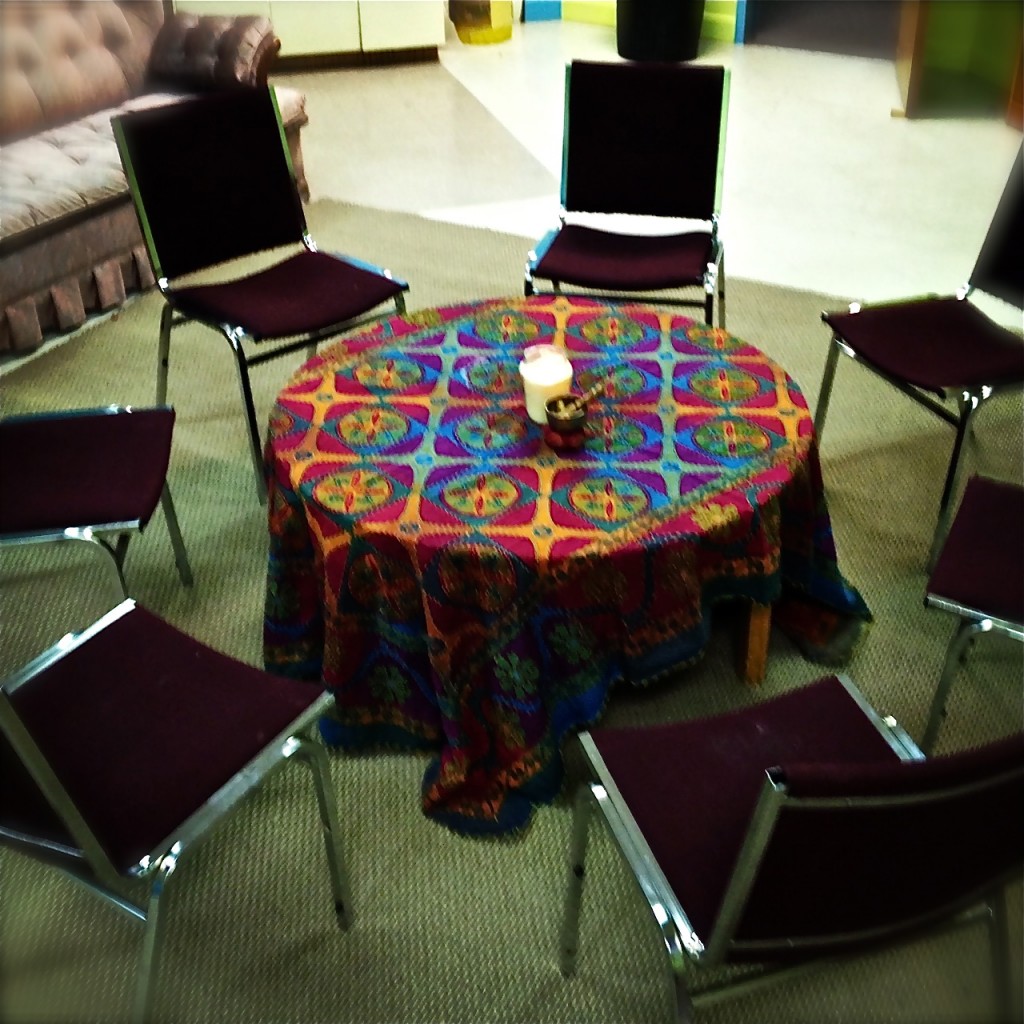
It’s another Tuesday night and I prepare once again for my small circle of writers. I arrive early and place the low round table in the centre, covered with the colourful tapestry that comes with me to every workshop. Like the threads of the tapestry, many stories will be woven together tonight.
At the centre of the table is always the candle – the warmth that holds us together. Next to it is my Tibetan singing bowl and whatever talking piece has been selected for this evening’s sharing time. Sometimes the participants bring talking pieces that are meaningful to them. Tonight one woman has brought a beautiful black polished stone, adorned with a dragonfly mosaic. “It represents transformation,” she says.
The women (and occasionally men) settle into their chairs and I welcome them with the ringing of the bell. We sit quietly, focusing on our breath as we wait for the end of the rich tone. After the bell, a centring piece is read – a poem by Mary Oliver or a blessing by John O’Donohue. Then the talking piece is passed, and we share the details of how our weeks have gone – from the mundane to the profound. None of this is about writing, but it’s important nonetheless. Our writing voices emerge out of our personal stories and we know that those stories will feel more safe in a circle of people we trust. Only three weeks in, and we are already bonded, sharing increasingly more vulnerable stories with each other.
Next they begin to share the pieces they’ve been working on throughout the week. “I didn’t have much time,” one apologizes, or “it’s not very polished,” says another, or “it’s nothing great,” says yet another, and yet each time they share, I marvel at how profound and beautiful their simple offerings are. This week, they’ve written a dialogue between the voices in their heads – the one that wants something new and the one that’s resisting. Their individuality and shy dreams shine through their pieces.
Tonight we are exploring what voice means – both our own voices and the voices of those people and creatures we want to bring into our writing. I pull out a set of cards depicting forest creatures – the Elementals designed by my intuitive friend Thomas – and they are invited to write in the voice of the creature they see on the cards they select.
As they write, I boil water for tea. Tea goes well with writing and storytelling. There is silence in the room, each person wandering away from the space for awhile, imagining themselves in the forest with a mesmerizing creature that has a message meant just for them.
They share their pieces, surprised by how much wisdom flows out of them. Before long, the conversation has veered far away from writing. We’re talking about our connections to the earth, our secret longings, our hidden shame, our deepest fears. I say very little and offer only little guideposts to help them know the conversation is good and true and heading in the direction it’s meant to head in. In this moment, I am not teacher but host. It is their wisdom that is emerging – their truth, their gifts. I am here simply to help them unleash it.
As I listen, I find myself grinning at the beauty of this circle and all of the others like this that I have had the pleasure of hosting. Each offering I make, the right people show up, the right voices emerge, and the right truth is spoken. Always, the people that are drawn to what I offer are open-hearted and open-minded. They come because they want to learn and grow. They come because they are beginning to find the courage to explore and share their own stories. I am always fascinated by how unique and wise each person is.
Often, early in our time together, there is resistance in one or two of them, but usually by the end, the resistance has softened and openness has taken its place. Only once has someone stopped coming because she wasn’t prepare to process the depth of feelings that surfaced for her in the circle.
The evening ends quickly and they are given their next assignment. This week, they will write about place. They’ll find a place that feels meaningful to them and they’ll find the unique quality and voice of that place. I have no doubt that once again they’ll be surprised at what shows up in their writing.
One more time, the talking piece is passed, and we share what we learned or what intentions we wish to set for the week ahead. The bell is wrung one more time, and we begin to leave the circle and depart for our various homes.
I drive home, taking the long way through the park, savouring the magic of the night. This is my greatest dream coming true, circle by circle, story by story. I am honoured and blessed to be the host of so much goodness.
by Heather Plett | Aug 28, 2012 | calling, circle, Community, family, journey, prayer, Trust, women
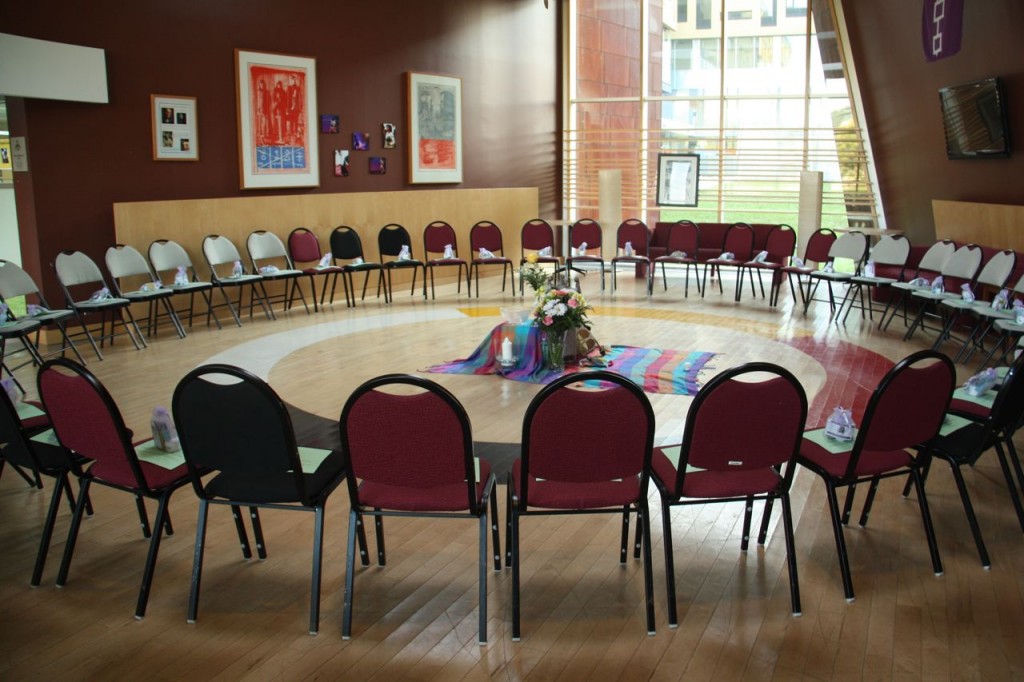 It seems appropriate and metaphorical that my journey to the Gather the Women event I was co-hosting was a long and arduous journey, and yet filled with moments of beauty and grace. The thirty-five hours I’d planned to spend on a train turned into forty-five and a half. I’d looked forward to the many hours of reading, writing, contemplation, and staring out the window (especially after the hard week before), but there’s only so much of that a person can take before the body begins to complain.
It seems appropriate and metaphorical that my journey to the Gather the Women event I was co-hosting was a long and arduous journey, and yet filled with moments of beauty and grace. The thirty-five hours I’d planned to spend on a train turned into forty-five and a half. I’d looked forward to the many hours of reading, writing, contemplation, and staring out the window (especially after the hard week before), but there’s only so much of that a person can take before the body begins to complain.
The moments, though, when I watched a moose run across a pond, or a great blue heron flap its mighty wings as it lifted itself out of the water, or a perfect circle of sunlight streaming out of a dark cloud, made the difficult journey bearable.
When I finally arrived in Peterborough, along with the other three members of the planning committee, I was weary but excited for what the next four days would bring. Forty-five women were gathering from across North America to sit in circle, share stories, and honour their feminine wisdom. I felt incredibly humbled to have the opportunity to host such a gathering. (Side note: I just realized that there was one woman for every hour I spent on the train! That thought makes me smile.)
The night before the gathering was to begin, I got bad news that almost convinced me to return home. The results of my Mom’s CT scan had come back. It was confirmed that the cancer she’d been treated for over the past year was still growing in her abdomen. Grief swept in and encompassed me. I didn’t know how I would make it through the rest of the week and do the job I needed to do.
I shared the news with the planning committee, and they surrounded me with love and community. “Go home if you need to,” they said. “We’ve got your back.”
The next morning, I decided I’d stay. Something told me that being part of this circle of women would help me have the courage to return home to what I needed to face.
It wasn’t easy. The details of gathering – putting together registration packets and gift bags, writing flip charts, and cutting string for my creative workshop – felt so trivial in light of what I was dealing with. At the same time, though, creating a space of comfort and inspiration for the women who were traveling many miles (literally and metaphorically) to be there was not trivial at all.
Before the opening circle began, I stepped into the room where creative women were preparing to sell their art in a small marketplace. Near the entrance was the beautiful art of Maia Heissler. She was in the midst of hanging her beautiful Forest Friends on a small hand-made tree when I stopped to chat with her.
“I’ve created these specially for the gathering,” she said. “They tell the stories of women gathering. This one is of a woman celebrating, surrounded by the women who love her. This one is of a woman who’s been dealt a basket of sorrows. Her community of women are helping her bear the burden.”
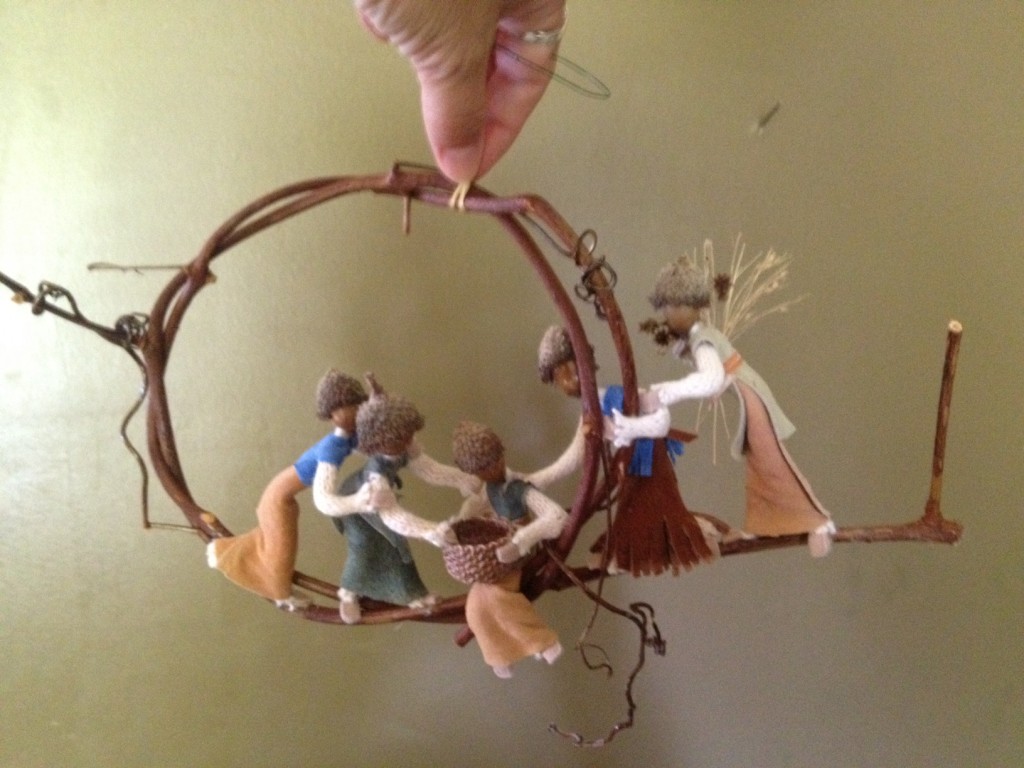
“That one,” I said. “I think I need to go home with that one. I AM that woman with the basket of sorrows.” I didn’t tell her what was in my basket, but I asked her to hold the piece until I’d decided whether I could afford to buy it.
On Thursday evening, there was levity and celebration in the opening celebration. I could hardly bear to be in the room. I spent most of the evening lying on my bed, alone in my room. I emerged only periodically to hear some of the stories that were being shared. Another woman shared how she, too, had taken the train and been subjected to lengthy delays.
Friday morning’s opening circle was beautiful and powerful. One by one we shared stories of how we’d come to be in this circle. Each of us placed a meaningful object in the centre of the circle and then added water we’d brought from our various homes into a collective bowl. When it came my turn to share, I added water that I’d brought from the graveyard where my son Matthew is buried and said that it felt like I was carrying a vial of tears with me. I said nothing about my mom. Something told me to hold that story close for the time being.
In the afternoon, I lead a workshop on storytelling, courage, and community. The women were invited to break into small circles of three to share stories of times in their lives when they’d had courage and times in their future when courage would be required of them. Out of those stories, they chose words and phrases to put onto prayer flags to take home and remind themselves of how the community supports their courage.
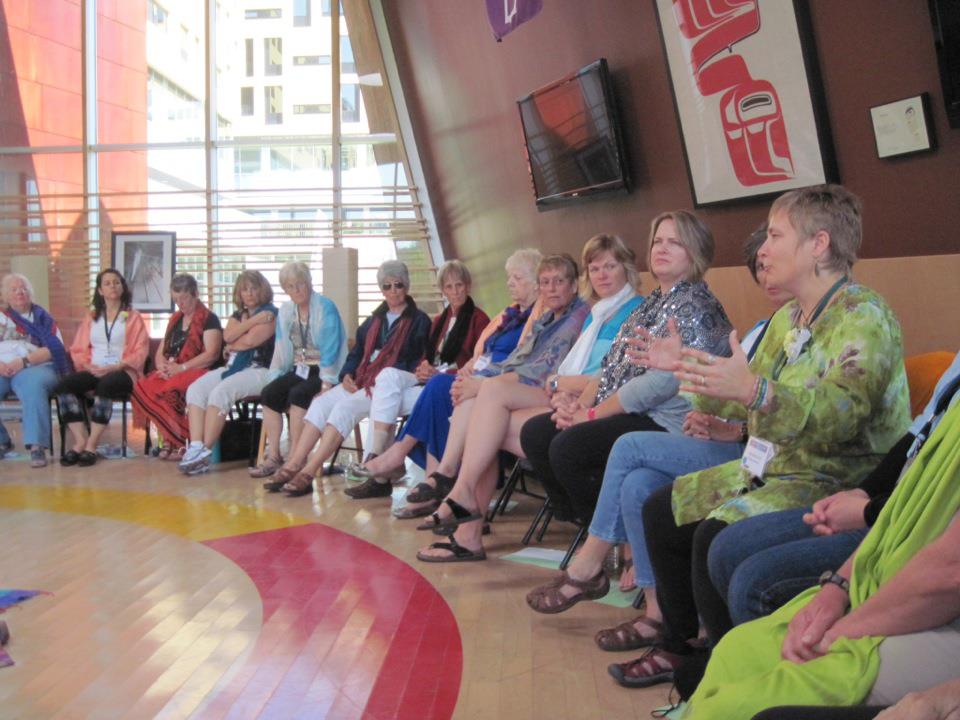
I didn’t participate in the story-sharing. Instead, I walked around with my camera, taking pictures of the beautiful faces as they softened and grew more vulnerable within the safe circles of trust.
Before the weekend ended, I bought the art piece of the woman with the basket of sorrows. Though it felt like more money than I could justify spending on myself, I knew I needed to take it home with me.
As the weekend progressed, I found my spirits lightening despite the heaviness in my chest. I was able to celebrate and dance and sing around the campfire. On Saturday afternoon, together with my delightful and spontaneous friend and mentor Diane, I went swimming in my clothes in the river that runs through the centre of Trent University. We convinced our new young friend Lindsay to join us. It was a lovely moment of lightness and joy.
As we drew nearer to the closing circle on Sunday morning, I contemplated whether or not to share the story of my Mom with the circle. I was a little conflicted. As one of the hosts of the gathering, I was somewhat reluctant to draw too much attention to myself, and yet as a member of the circle, it didn’t feel right to leave the circle without entrusting them with my pain. The beauty of the circle is that we all hold equal positions and one’s pain or joy is as important as another’s.
Just before the closing circle, one of the women with whom I hadn’t spoken much approached me. “You are a gifted woman, and you give so much to the group,” she said. “And yet there’s a sadness in your eyes. I want to honour whatever it is that gives you sadness.” At that moment, I knew I needed to share.
It took quite awhile for the talking piece to make its way to me. As it traveled, I listened deeply to the stories that were shared. So many women were going home with renewed courage and hope and strength after being part of the circle. It was a beautiful thing to behold.
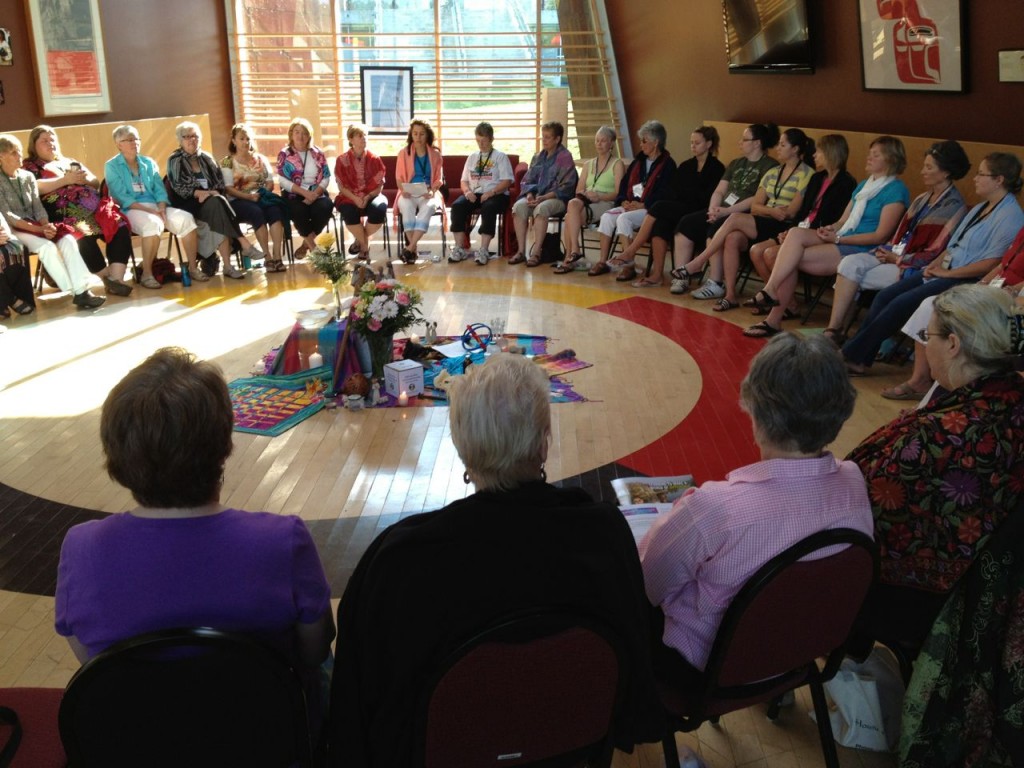
When it came my turn, I began by saying that I felt like I’d just been held in the arms of the Great Mother. “I am conflicted,” I said. “It is always so exciting for me to come to an event like this, because I know that this is my calling – to be in places like this, and to teach more people about storytelling, circles, courage, and community. I want to go home and do big things – teach, write and speak. And yet I have received a new calling this weekend – one that I am much more reluctant to follow.”
And then I shared the news I’d gotten – that my own mother might not be with me much longer. “My calling now,” I said, “is not to do big things, but to do small things – to sit in circle with my mother and be with her as she journeys toward the end of her life here with us.”
I held my water vial up and said “before we meet again, there will be many more tears in this vial.” I looked around the room and saw that nearly every woman in the circle had tears in her eyes. My pain had become their pain.
What an incredibly moving thing it is to know that you don’t cry alone! I am surrounded, in that circle and in the circles I returned to when I came back home, with so much love and community.
Yes, I am a woman who has been dealt a basket of sorrows (as is my mom, my sister, my mom’s sister, my sisters-in-law, and the other women who surround my mom – and of course there are many men in that circle too), but I know that I don’t have to carry it alone, and for that I am immensely grateful.
On Monday, the day after Gather the Women ended, my sister and I went to see the oncologist with my Mom and her husband. There we were told that Mom may be with us for six months or more, but probably less than a year. She has the option of taking more chemo treatments, but that will merely prolong her life somewhat and not stop the growth of the cancer. In the coming months, we need to prepare for her journey into the next life.
I didn’t take the train home on the return trip, and yet I know that there is a long and arduous journey ahead of me in the coming months. I also know that that journey will have intermittent moments of peace, beauty, and grace, just like my train ride did.
This I know – we are surrounded by love and we are held in the arms of the Great Mother/Father. May I continue to trust in that.
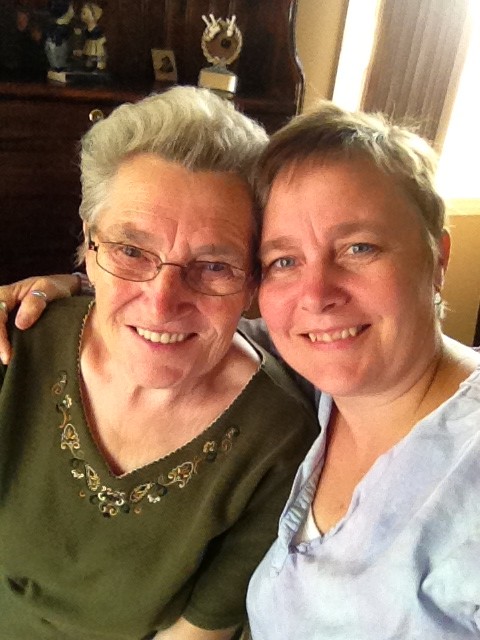
Mom and me
by Heather Plett | Jul 10, 2012 | circle
Yesterday I had the privilege of participating in a sharing circle for the Truth and Reconciliation Commission. A few years ago, our government apologized to our First Nations people for the injustice that had been done for generations, when young children were taken away from their families and forced to live in residential schools. These circles offer all of us an opportunity to seek healing as a country.
In the circle, we were asked to share how we had personally been impacted by residential schools, what we believe reconciliation means, and how our countries and communities can heal. Only a few of the people in the circle had been to residential schools themselves, but all of us have been impacted by the deep wounds our country bears.
I sat with tears in my eyes as I listened to the stories. One woman shared about how bewildered she’d been as a four year old when her older sister had disappeared from their home, and then how she too had one day disappeared. Another women talked about the abuse she’d suffered at the hands of her alcoholic husband who’d been a residential school survivor. A young man, who works as a videographer at sharing circles like this one, talked about how the priests and nuns at some of these schools had put needles into the tongues of children who were caught speaking their indigenous language while at school.
Almost every First Nations person who talked expressed the shame that the residential schools system had instilled in their culture. Whether they’d been to residential schools themselves or been raised by parents or grandparents who were survivors, each and every one of them carried the burden of being an oppressed people, made to feel less than their oppressors. It was a painful reminder that healing from oppression takes many generations.
As the talking piece rounded the circle, I wrestled with what I would offer into the circle. Did I have any right to say anything in the midst of this pain? And yet… did I have a right to remain silent?
An interesting thing happened around the diverse and multicultural circle. Those who shed the most tears were often the people of caucasian descent. It was clear that the shame in the circle was not only among the indigenous people. Those who are descendants of the oppressors also need to be healed from the pain that their ancestors have caused.
By the time the talking piece finally reached me, I knew what I needed to say.
“My name is Heather… and… more than anything, I don’t want to be racist. And yet… there is one thing I know and that is that reconciliation needs to begin with me. Before I can be part of the healing process, I need to peel away the layers of my own stories, find the seeds of the oppressor buried in me, and address them.”
It’s easy for me to say that the residential schools are not my burden to bear. I didn’t pull any children out of their homes or pierce their tongues with needles. I don’t need to carry the blame for that.
And yet… as the writers of The Shadow Effect remind me, we cannot escape the shadows of our ancestors. The darkness that was in them still exists in us. The shadow that caused them to take brutal action against others remains rooted in our culture and we cannot expect it to go away unless we address it head on.
We are all oppressors.
We are all colonizers.
We all have the shadow in us.
We can’t fight the shadow and we can’t bury it. The only way to address it is to befriend it, to peel away the layers that keep it hidden, look it directly in its face, and take the lessons we need to learn from it.
Here is a piece of my shadow that I hate to look at… I am a racist. I judge other people based on their race. I don’t do it overtly, and I fight desperately hard not to do it at all, but I know that when I see a homeless person on the street, or I sit on the bus next to someone who smells funny, a tiny little shadowy voice inside me whispers in my ear that it has something to do with their race. That’s what oppression does – it infects generations of descendants on both sides of the divide whether they want to admit it or not.
Recently I heard Bishop Desmond Tutu talk about the post-apartheid days in South Africa. He’d been a leader in the movement to end apartheid, but one day he realized how deep the roots of oppression had grown in his own heart. In an airplane one day, he’d discovered that the pilot was a black African man. His first thought was “Isn’t this great? We’ve finally arrived! We’re able to fly planes now!” But then, when the plane hit turbulence, the instantaneous thought that entered his mind was “is a black man capable enough to keep us safe?” That’s when he realized that deep in his heart, he’d let the oppressors convince him that his people had less value.
That’s how insidious oppression is. Even when we don’t recognize it, there can still be tiny hints of it that emerge in our most threatened or vulnerable moments.
When I look at the roots of my own personal battle with racism, I can find the stories in my past that helped it grow. When I was twenty one years old, I was raped by an Aboriginal man who smelled of glue and rubbing alcohol and had a large tattoo of a naked woman on his arm. He climbed through my window and destroyed my innocence and illusions of safety in my own home.
Now, as I look back at that event in my life, through the thickening lens of the many years that have passed, I can see how that pain story (and others like it) has contributed to the way that I have lived and the way I have treated people.
There are so many complex layers of pain in that story – both my pain and that of my rapist. That’s what oppression does – it builds layers of pain on us as individuals and us as communities of people, layers we can’t easily shake. My rapist, bearing the burden of addiction – most certainly as the result of the oppression he’d born and his ancestors had born before him – becomes the aggressor. The oppressed becomes the oppressor as he attempts to colonize women’s bodies through acts of rape and by tattooing their naked bodies on his skin. Pain is infectious – it wants to spread from one person to the next.
I, in turn, a child of privilege and a descendent of oppressors, in that moment became the oppressed – the victim. It’s a vicious cycle.
The next bit is the tricky part… do I let that pain story continue unchallenged? Do I justify my racism, and continue to look down my nose at the homeless First Nations people I encounter on the downtown streets? Do I toss everyone into the same category as my rapist? Do I continue the cycle of abuse?
Or do I take a good hard look at the shadow and see what I can learn from it?
This is not an easy story to tell. I want you to think that I have never acted out of racist intent – that I have been kind to every person I’ve met, regardless of their race or social status. I want you to believe that I am above that and have never perpetuated the cycle of abuse. I have very good relationships with people of many cultures and I try desperately hard to treat them all with respect and equality. In fact, in my university days, my best friend was a Aboriginal man, and I am now married to a Metis man. See? I have overcome the cycle! That’s the story I want you to know about me.
And yet… the shadow still emerges sometimes. I can’t deny it. I hurt people by not honouring their dignity. I let my fear keep me from looking people in the eyes sometimes. I avoid neighbourhoods where I might encounter my shadow.
As I sat in that circle last night, I wept for the pain that I had born and the pain that I had caused. I wept for the colonizers and the colonized. I wept for the pain stories that all of us carry and all of us continue to perpetuate, even in small and seemingly harmless ways. I wept for the shame of being a child of the oppressors. I wept for my rapist and for his family – for the pain they continue to carry. I wept… and then I offered an apology for all of the little ways that I had perpetuated the cycle.
Before it was my turn, two young Aboriginal men had shared their stories of trying to rise above the oppression and become leaders and change-makers in their communities. Their stories inspired me, and – more importantly – offered me one more piece of my healing journey. Seeing young men who are willing to stare down the shadow, rise above it, and bring their people’s pain stories into the light offered me a different paradigm for Aboriginal men than my rapist had imprinted on me. It was an honour to sit in circle with them.
After the circle had ended, I asked each of those men if I could give them a hug. They both were more than willing to accept. Perhaps in that gesture I have offered them a bit of healing too.
The last question each of us was asked to address was our thoughts on how our country will be healed. That question is far too big for me. I don’t know what it takes to heal a country and I don’t think anyone does.
I do know, however, that what heals me begins to heal a country. And the thing that will continue to offer me healing is the opportunity to sit in circle. Sitting in circles peels away the layers of hierarchy that we are all so used to in our culture. Sharing stories offers us the opportunity to see each other through new lenses. Befriending people who are different from us helps us shift our paradigms and change the world one friendship at a time.
Circles give us the chance to sit in equal positions, looking into each others’ eyes, listening deeply to each others’ stories, and re-building a bit of that trust that has been destroyed by so much of our history.
We need more circles. We need circles in our classrooms, circles in our governments, and circles in our homes. We need circles and we need friendship. That’s where healing begins.
by Heather Plett | Jun 16, 2012 | circle, Labyrinth, mandala
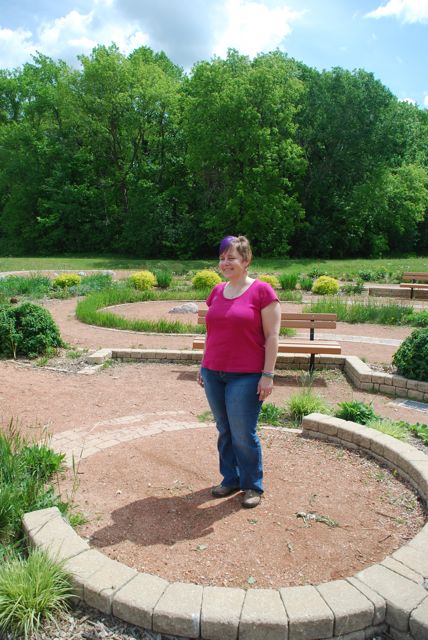
me at the centre, taken by Jo-Anne
The last time I went to the labyrinth, my friend Jo-Anne came with me. She’d never been before and was curious about what drew me so regularly to the park across the river.
At the centre of the labyrinth, there are two benches facing each other. After walking the path, I perched on one of the benches while Jo-Anne stood in the middle with her camera. As we chatted, I saw a look of delight cross her face.
“Have you ever noticed the echo when you stand in the centre?”she asked.
No, I hadn’t. I’d stood at the centre many times, but I was almost always alone and rarely said anything out loud.
“Stand right here,” she said. I joined her at the centre and started talking. Sure enough – the tiniest of echos reverberated from my voice, but only if I stood exactly in the centre.
Trained as a scientist, Jo-Anne was quick to figure out what was causing the echo – the combination of the slight bowl shape of the labyrinth and the benches.
More mystic than scientist, I prefer to think it’s a manifestation of the energy that’s available when you spiral closer to centre. Committing to the journey, trusting the path, you arrive at centre and the God of your understanding, the source of your energy, meets you there in the echo of your own voice.
The truth is, though, there’s nothing really mystical about the labyrinth itself. Pragmatically speaking, it’s just a circular, winding path that someone has lovingly built, filling in the in-between spaces with natural prairie plants (that Jo-Anne knows all the names for and I know only as “the one with wispy pink flowers”), and adding a few benches here and there for comfort. Anyone can build a labyrinth. My friend Diane has one in her back yard.
Yes, there is something sacred about the space, but the same can be said about any space. The easy chair you like to curl up in with your favourite book is sacred too. So is the driver’s seat of your car. Or the lawnchair you bring to your daughter’s soccer games. Or the little patch of garden you faithfully nurture. Sacred simply means that God is there, and… well, God is everywhere. We just have to open our senses and we will see/hear/touch/smell/taste God. (Fill in your own name for God, if you like.)
Jo-Anne is right – there’s a logical explanation for the echo. But that doesn’t mean that the next time I’m standing there I won’t speak words into the labyrinth, hear the echo returning to me, and know that God is there and that my words are imbued with power that I can take with me when I leave the labyrinth.
Sacred space is what we make of it. Sacred space is simply us bringing our open hearts to a place and letting that place be a vessel for Spirit to be in communion with us.
For me, labyrinths are especially sacred because the winding path, the meditation of putting one foot in front of another, the simple slow breathing as I walk, and then the pause at the centre help me move gently into an openness where God can speak. When I stand at the centre, it’s because I’ve been intentional about silencing the voices that get in the way of hearing the still small voice that reminds me of who I am.
I don’t need the echo, but it’s just one more way that God uses science to remind us of Her presence when we’re ready to pay attention.
If you’re curious about labyrinths, mandalas, and circles, join me on June 26th at 7 pm Central for a free call. (More info. in this post.) Register below.









